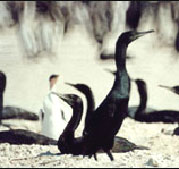These are group of around 16 small limestone desert islands located 25 km southeast to the main island of Bahrain. The flat desert islands are surrounded by shallow water no deeper than six meters. Mudflats are common around the islands and are visited by wading birds. Salt marshes and other water grasses flourish there.
A large number of cormorants are found on Hawar islands, as well as large migratory wader species of birds including the Greater Flamingos. These islands are important breeding sites for some important regional species. The small island of Sawad al-Janubiah supports the largest known breeding colony in the world of Socotra Cormorant and significant numbers of Greater Flamingo and Black-headed Gull, and the Sooty Falcon, a black falcon about one quarter of the size of the ordinary falcon.
Notable marine species in the surrounding waters include the endangered dugong and several species of marine turtles. There are seagrass meadows that support grazing marine animals such as the dugong, and Green turtles. The islands are also home to the bottlenose dolphin.
Several hundred camels roam the island. They are not indigenous, and were brought to Hawar in the 19th century.
Bahrain created a Wildlife Sanctuary around Hawar Islands by Royal Decree in 1995. The islands are in relatively pristine condition because access is severely restricted by the coast guard and military.
Ramsar site no. 921
The Ramsar Convention on Wetlands came into force for Bahrain on 27 February 1998. Tubli Bay and Hawar Islands are the country’s 2 sites designated as Wetlands of International Importance, with a total surface area of 6,810 hectares.
References: www.ramsar.org, www.adias-uae.com, State of Bahrain Ministry of Information, Washington, D.C.



